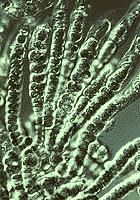Oxygen in the Atmosphere

"It is widely believed that 2000 million years ago the cyanobacteria—oxygen eliminating photosynthetic prokaryotes that used to be called blue-green algae (...) effected one of the greatest changes this planet has ever known: the increase in concentration of atmospheric oxygen from far less than 1% to about 20%. Without this concentration of oxygen, people and other animals would have never evolved"
Margulis, Lynn and Karlene V. Schwartz.
Five Kingdoms, 2nd edition. W. H. Freeman and Company 1988. p28.
also at
Gaia by Brig Klyce
The most important change in Earth's environment since life began is the buildup of free oxygen in the air. Before life became established on Earth, and even for some one or two billion years afterwards, the air contained no free oxygen. Today, the atmosphere is 21 percent oxygen. The significant buildup probably began about two billion years ago, with the appearance of Cyanobacteria (see photo on left).
 At the beginning of the Proterozoic the cyanobacteria - photosynthetic prokaryotes also known as blue-green algae - brought about one of the greatest changes this planet has ever known: a massive increase in the concentration of atmospheric oxygen. When the oxygen began to accumulate, it constituted a wholesale pollution of the environment, a "holocaust" for all living things on Earth. Some bacteria however were able to endure the oxygen atmosphere. A symbiosis between bacteria and the formerly free-living mitochondria enabled eukaryotes to evolve in response to the crisis. Oxygen-based metabolism came into being. The environment changed and life randomly followed.
At the beginning of the Proterozoic the cyanobacteria - photosynthetic prokaryotes also known as blue-green algae - brought about one of the greatest changes this planet has ever known: a massive increase in the concentration of atmospheric oxygen. When the oxygen began to accumulate, it constituted a wholesale pollution of the environment, a "holocaust" for all living things on Earth. Some bacteria however were able to endure the oxygen atmosphere. A symbiosis between bacteria and the formerly free-living mitochondria enabled eukaryotes to evolve in response to the crisis. Oxygen-based metabolism came into being. The environment changed and life randomly followed.
"oxygen revolution 1800 Myr. Although animals need oxygen to survive, primitive life began in the absence of free oxygen, and when oxygen built up in sea-water, it was a deadly poison for organisms unequipped to deal with it. Oxygen originated mainly as a by-product of the growth of plants. For more than half the Earth's history, the formation of sulfates and rich iron ores (banded iron formations) eliminated oxygen almost as fast as it was produced, but eventually these geochemical processes were exhausted. The mobilization of uranium in locally oxygenated conditions created natural reactors C. 2000 Myr ago. The definitive worldwide change that signaled the appearance of free oxygen was the appearance of red beds, characterized by abundant red oxides of iron (ferric oxides) in sedimentary rocks. The banded iron formation - red bed transition occurred 1800 Myr ago (geological data given in B. F. Windley, The Evolving Continents, Wiley, 1977; and H. H. Read and J. V Watson, Introduction to Geology, Vol.2, Macmillan, 1975)."
Nigel Calder, Timescale, p.264 (1984, Hogarth Press, London)
The beginning of the oxygen build-up allowed the appearance of the first eukaryotic cells. Most bacteria don't require oxygen, and many (especially the Domain Archaea) are poisoned by oxygen. All eukaryotic cells require oxygen for their more complicated and more efficient metabolism. There also has to be oxygen for there to be ozone, to shield the surface of Earth from damaging ultra-violet rays. Only with such shielding is it safe for life to move onto shallow water and eventually out onto land.
page by
M.Alan Kazlev
page uploaded 27 October 2002
(on Kheper site uploaded 23 May 1999)
checked ATW060124, edited RFVS111108
 At the beginning of the Proterozoic the cyanobacteria - photosynthetic prokaryotes also known as blue-green algae - brought about one of the greatest changes this planet has ever known: a massive increase in the concentration of atmospheric oxygen. When the oxygen began to accumulate, it constituted a wholesale pollution of the environment, a "holocaust" for all living things on Earth. Some bacteria however were able to endure the oxygen atmosphere. A symbiosis between bacteria and the formerly free-living mitochondria enabled eukaryotes to evolve in response to the crisis. Oxygen-based metabolism came into being. The environment changed and life randomly followed.
At the beginning of the Proterozoic the cyanobacteria - photosynthetic prokaryotes also known as blue-green algae - brought about one of the greatest changes this planet has ever known: a massive increase in the concentration of atmospheric oxygen. When the oxygen began to accumulate, it constituted a wholesale pollution of the environment, a "holocaust" for all living things on Earth. Some bacteria however were able to endure the oxygen atmosphere. A symbiosis between bacteria and the formerly free-living mitochondria enabled eukaryotes to evolve in response to the crisis. Oxygen-based metabolism came into being. The environment changed and life randomly followed.